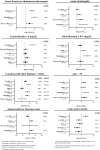Systematic review and meta-analysis of the 2010 ASGE non-invasive predictors of choledocholithiasis and comparison to the 2019 ASGE predictors
- PMID: 35072902
- PMCID: PMC8956528
- DOI: 10.1007/s12328-021-01575-4
Systematic review and meta-analysis of the 2010 ASGE non-invasive predictors of choledocholithiasis and comparison to the 2019 ASGE predictors
Abstract
In 2019, the American Society for Gastrointestinal Endoscopy (ASGE) guideline on the endoscopic management of choledocholithiasis modified the individual predictors of choledocholithiasis proposed in the widely referenced 2010 guideline to improve predictive performance. Nevertheless, the primary literature, especially for the 2019 iteration, is limited. We performed a systematic review with meta-analysis to examine the diagnostic performance of the 2010, and where possible the 2019, predictors. PROSPERO protocol CRD42020194226. A comprehensive literature search from 2001 to 2020 was performed to identify studies on the diagnostic performance of any of the 2010 and 2019 ASGE choledocholithiasis predictors. Identified studies underwent keyword screening, abstract review, and full-text review. The primary outcomes included multivariate odds ratios (ORs) and 95% confidence intervals for each criterion. Secondary outcomes were reported sensitivities, specificities, and positive and negative predictive value. A total of 20 studies met inclusion criteria. Based on reported ORs, of the 2010 guideline "very strong" predictors, ultrasound with stone had the strongest performance. Of the "strong" predictors, CBD > 6 mm demonstrated the strongest performance. "Moderate" predictors had inconsistent and/or weak performance; moreover, all studies reported gallstone pancreatitis as non-predictive of choledocholithiasis. Only one study examined the new predictor (bilirubin > 4 mg/dL and CBD > 6 mm) proposed in the 2019 guideline. Based on this review, aside from CBD stone on ultrasound, there is discordance between the proposed strength of 2010 choledocholithiasis predictors and their published diagnostic performance. The 2019 guideline appears to do away with the weakest 2010 predictors.
Keywords: American Society for Gastrointestinal Endoscopy; Choledocholithiasis; Cholelithiasis; ERCP; Endoscopic retrograde cholangiopancreatography.
© 2022. The Author(s).
Conflict of interest statement
No disclosures or conflicts of interest relevant to this submission. An abstract of this study was presented at DDW 2021 as an ASGE poster.
Figures
References
Publication types
MeSH terms
Grants and funding
LinkOut - more resources
Full Text Sources
Miscellaneous




